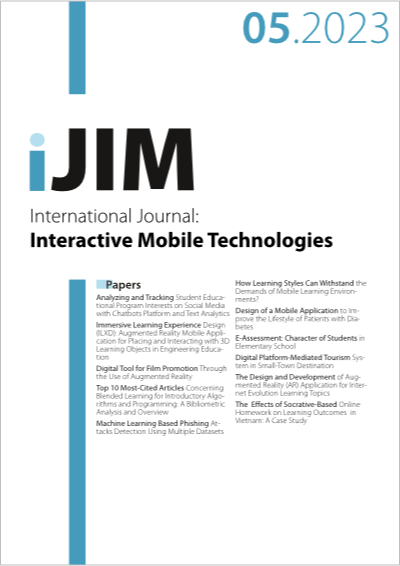Top 10 Most-Cited Articles Concerning Blended Learning for Introductory Algorithms and Programming: A Bibliometric Analysis and Overview
DOI:
https://doi.org/10.3991/ijim.v17i05.36503Keywords:
blended learning, programming, bibliometric, most-citedAbstract
Blended learning, also known as mixed-mode instruction, combines in-person and online instruction. Blended learning is widely used in school and university subjects. This research aims to determine how blended learning has been applied to algorithms and programming courses over the last 20 years. This study analyzes the quality and quantity of scientific publications using bibliometric techniques and then provides an overview of how blended learning is used and its impact. For this analysis and review, this study conducted a bibliometric analysis of articles published in the last 20 years (2000–2021) and then presented the 10 most cited articles. We established the following criteria for articles: 1) sourced from the Scopus database, 2) concerned about blended learning in algorithms and programming, and 3) publication is limited to articles published in indexed international journals and proceedings. The VOSviewer and MS-Excel applications help with data presentation in this method. We collected 240 articles that met these criteria from the Scopus database, which contained 297 articles published between 2000 and 2021. The most-cited article received 52 citations, while the least received only 3. The top 10 most cited articles are from the following countries: 1) Norway, 2) Serbia, and 3) Saudi Arabia. We divided the articles into categories based on the Sustainable Development Goals (SDGs). The findings of this study can be used as a reference for state-of-the-art and novelty, as well as for the dissemination of scientific references related to the use of blended learning for introductory algorithms and programming.
Downloads
Published
How to Cite
Issue
Section
License
Copyright (c) 2023 Agariadne Dwinggo Samala, Usmeldi, Taali, Yose Indarta, Apdoludin, Muhammad Hakiki, Kelvin Leong

This work is licensed under a Creative Commons Attribution 4.0 International License.


